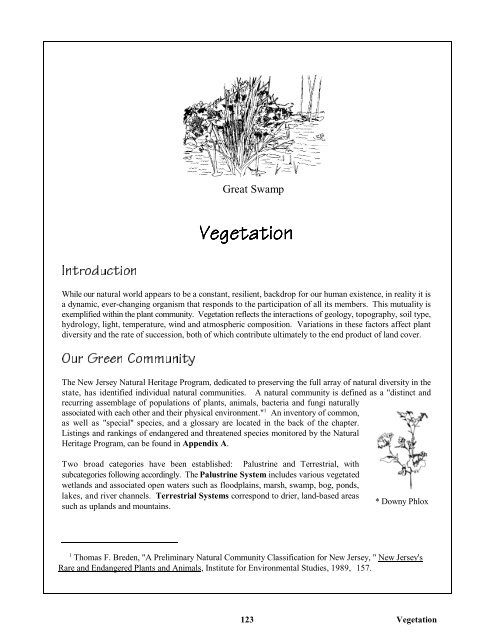A Natural Resource Management Guide for the County of Morris A ...
A Natural Resource Management Guide for the County of Morris A ...
A Natural Resource Management Guide for the County of Morris A ...
You also want an ePaper? Increase the reach of your titles
YUMPU automatically turns print PDFs into web optimized ePapers that Google loves.
Great Swamp<br />
Vegetation<br />
Introduction<br />
While our natural world appears to be a constant, resilient, backdrop <strong>for</strong> our human existence, in reality it is<br />
a dynamic, ever-changing organism that responds to <strong>the</strong> participation <strong>of</strong> all its members. This mutuality is<br />
exemplified within <strong>the</strong> plant community. Vegetation reflects <strong>the</strong> interactions <strong>of</strong> geology, topography, soil type,<br />
hydrology, light, temperature, wind and atmospheric composition. Variations in <strong>the</strong>se factors affect plant<br />
diversity and <strong>the</strong> rate <strong>of</strong> succession, both <strong>of</strong> which contribute ultimately to <strong>the</strong> end product <strong>of</strong> land cover.<br />
Our Green Community<br />
The New Jersey <strong>Natural</strong> Heritage Program, dedicated to preserving <strong>the</strong> full array <strong>of</strong> natural diversity in <strong>the</strong><br />
state, has identified individual natural communities. A natural community is defined as a "distinct and<br />
recurring assemblage <strong>of</strong> populations <strong>of</strong> plants, animals, bacteria and fungi naturally<br />
1<br />
associated with each o<strong>the</strong>r and <strong>the</strong>ir physical environment." An inventory <strong>of</strong> common,<br />
as well as "special" species, and a glossary are located in <strong>the</strong> back <strong>of</strong> <strong>the</strong> chapter.<br />
Listings and rankings <strong>of</strong> endangered and threatened species monitored by <strong>the</strong> <strong>Natural</strong><br />
Heritage Program, can be found in Appendix A.<br />
Two broad categories have been established: Palustrine and Terrestrial, with<br />
subcategories following accordingly. The Palustrine System includes various vegetated<br />
wetlands and associated open waters such as floodplains, marsh, swamp, bog, ponds,<br />
lakes, and river channels. Terrestrial Systems correspond to drier, land-based areas<br />
such as uplands and mountains.<br />
* Downy Phlox<br />
1<br />
Thomas F. Breden, "A Preliminary <strong>Natural</strong> Community Classification <strong>for</strong> New Jersey, " New Jersey's<br />
Rare and Endangered Plants and Animals, Institute <strong>for</strong> Environmental Studies, 1989, 157.<br />
123<br />
Vegetation


